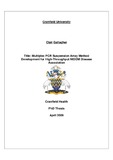JavaScript is disabled for your browser. Some features of this site may not work without it.
| dc.contributor.advisor | Cullen, David C. | |
| dc.contributor.advisor | Larcombe, Lee | |
| dc.contributor.author | Gallagher, Clair | |
| dc.date.accessioned | 2010-07-29T10:32:55Z | |
| dc.date.available | 2010-07-29T10:32:55Z | |
| dc.date.issued | 2009-04 | |
| dc.identifier.uri | http://hdl.handle.net/1826/4526 | |
| dc.description.abstract | Aim: This work sets out to use haplotype-based tagSNP selection and a systematic in silico analysis for design of multiplex-compatible PCR primer and SAT probe sets to capture maximum variation with minimum tests across candidate genes IGF1, IGFBP1 and IGFBP3. Additionally, the work aims to develop a number of robust, high-efficiency, high-specificity multiplex PCR constructs for amplification of these targets and to demonstrate the applicability of these target types to suspension array genotyping for non-insulin-dependant diabetes mellitus association facilitation. Methods: Haplotypes for predominantly European Caucasian populations were constructed and tagSNP selection performed using Haploview to capture maximum variation across candidate genes IGF1, IGFBP1 and IGFBP3. Extensive in silico analysis was performed for design, evaluation and selection of robust high-specificity primer and probe pairs, suitable for downstream multiplex PCR and SAT analysis. Singleplex endpoint and real-time PCR was performed for primer pair profile determination which informed multiplex PCR set construction and optimisation. The applicability of this complex target type to suspension array-based genotyping was investigated using a model probe pair using both quantum dot-encoded and fluorophore-encoded microspheres. Results: Haploview was used for haplotype construction and linkage disequilibriumbased tagSNP selection across candidate genes, reducing the number of SNP targets from 292 to 32 with minimal information loss. Extensive evaluation of potential tagSNPs was performed and 29 SNPs, representing 29 bins across target genes were designed for multiplex analysis. Singleplex end-point and real-time PCR was performed for primer pair profile determination which allowed four multiplex PCR sets to be constructed and optimised for simultaneous amplification of 14, six, five and two targets. The applicability of this complex target type (14-plex) to suspension array-based genotyping was demonstrated using a model probe pair. Conclusion: In silico analysis techniques have been applied for successful development of four robust multiplex PCR sets (14-plex, 6-plex, 5-plex and 2-plex) which display high-efficiency and target-specific amplification of tagSNPs, capturing maximum assaycompatible variation across candidate genes IGF1, IGFBP1 and IGFBP3 for European Caucasian populations. The applicability of these multiplex PCR constructs to suspension array-based genotyping has been demonstrated, thus paving the way for development of large multiplex suspension array-based genotyping assays using probes designed during the course of this work. This work offers the potential for comprehensive association analyses to become more accessible to the wider-scientific community by facilitating reduced genotyping burdens which allow increased accessibility for powerful association. | en_UK |
| dc.language.iso | en | en_UK |
| dc.publisher | Cranfield University | en_UK |
| dc.rights | This thesis is submitted in partial fulfilment of the requirements of the Degree of PhD. © Cranfield University, 2009. All rights reserved. No parts of this publication may be reproduced without the written permission of the copyright holder. | en_UK |
| dc.title | Development of an automated identification system for nanocrystal encoded microspheres in flow cytometry | en_UK |
| dc.type | Thesis or dissertation | en_UK |
| dc.type.qualificationlevel | Doctoral | en_UK |
| dc.type.qualificationname | PhD | en_UK |
